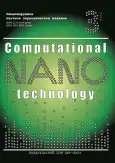Investigation of the Properties of Functional Ceramics Synthetized by the Modified Carbonate Method
- Authors: Rakhimov R.K.1,2, Pankov V.V.3, Yermakov V.P.1, Rashidov Z.K.1, Rakhimov M.R.1, Rashidov K.K.1
-
Affiliations:
- Institute of Materials Science of the SPA “Physics-Sun” of the Academy of Science of Uzbekistan
- Institute of Renewable Energy Sources
- Belarusian State University
- Issue: Vol 10, No 3 (2023)
- Pages: 130-143
- Section: NANOMATERIALS
- URL: https://journals.eco-vector.com/2313-223X/article/view/623750
- ID: 623750
Cite item
Abstract
This article explores the properties of functional ceramics synthesized using a modified carbonate method. The authors propose and develop new methods of ceramic technology to scale up the process of obtaining ceramic nanocomposites. The study describes a synthesis method for ceramic composite powders based on the use of carbonates as starting components. The production and investigation of nanocomposite materials are considered important steps in the development of advanced technologies. The developed ceramic material has the ability to generate pulsed radiation in the far-infrared range, which finds application in various fields, including medicine, engineering, sterilization, low-temperature drying, and agricultural product processing. The potential of this material is also noted for use in optical materials, catalysts, electronics, and other areas.
Full Text
About the authors
Rustam Kh. Rakhimov
Institute of Materials Science of the SPA “Physics-Sun” of the Academy of Science of Uzbekistan; Institute of Renewable Energy Sources
Author for correspondence.
Email: rustam-shsul@yandex.com
ORCID iD: 0000-0001-6964-9260
Doctor of Engineering; Head at the Laboratory No. 1
Uzbekistan, Tashkent; TashkentVladimir V. Pankov
Belarusian State University
Email: pankovbsu@gmail.com
ORCID iD: 0000-0001-5478-0194
Doctor of Chemistry, Professor
Belarus, MinskVladimir P. Yermakov
Institute of Materials Science of the SPA “Physics-Sun” of the Academy of Science of Uzbekistan
Email: labimanod@uzsci.net
ORCID iD: 0000-0002-0632-6680
senior research at the Laboratory No. 1
Uzbekistan, TashkentZhasurkhon Kh. Rashidov
Institute of Materials Science of the SPA “Physics-Sun” of the Academy of Science of Uzbekistan
Email: labimanod@uzsci.net
ORCID iD: 0000-0001-5167-1312
junior researcher at the Laboratory No. 1
Uzbekistan, TashkentMurod R. Rakhimov
Institute of Materials Science of the SPA “Physics-Sun” of the Academy of Science of Uzbekistan
Email: rustam-shsul@yandex.com
ORCID iD: 0000-0003-0686-5681
junior researcher at the Laboratory No. 1
Uzbekistan, TashkentKhurshid K. Rashidov
Email: labimanod@uzsci.net
ORCID iD: 0000-0002-9744-6249
senior researcher at the Laboratory No. 1
UzbekistanReferences
- Rakhimov R. US Patent No. US 5,707,911, 13.01.1999.
- Rakhimov R. US Patent No. US 6,200,501 B1, 13.03.2001.
- Rashidov Z.Kh. Russian patent: A method for enriching kaolin raw materials and a device for its implementation. Application No. 2020128986. Priority of the invention on September 1, 2020. Registration date May 19, 2021
- Rakhimov R.Kh., Gorlach R.S., Pankov V.V., Ermakov V.P. Scalable method for obtaining nanocomposites for devices generating pulsed radiation of the far infrared range. In: Applied problems of optics, informatics, radiophysics and condensed matter physics. Materials of the 7th International Scientific and Practical Conference. Minsk, 2023. Pp. 444-10–444-12.
- Letyuk L.M., Pankov V.V., Litvinov S.V. The mechanism of MnZn ferrite formation under thermovibropomol conditions. Powder Metallurgy. 1988. No. 11. Pp. 36–41. (In Rus.)
- Pankov V.V., Ivashenko D.V. New methods of modified ceramic technology for the synthesis of functional nanostructured systems. Computational Nanotechnology. 2021. Vol. 8. No. 2. Pp. 18–23. (In Rus.) doi: 10.33693/2313-223X-2021-8-2-18-23.
- Rakhimov R.Kh., Pankov V.V., Ermakov V.P. et al. Photocatalysts based on functional ceramics. Geliotekhnika. 2023.
- Bashkirov L.A., Pankov V.V., Letyuk L.M. et al. The mechanism of Mn-Zn ferrite formation under thermovibropomol conditions. In: Mechanoemission and mechanochemistry of solids. Materials All-Union Symposium. Rostov-on-Don, 1986. Pp. 15–16.
- Rakhimov R.Kh., Pankov V.V., Ermakov V.P. et al. Development of a method for obtaining ceramic nanocomposites using sol-gel technology elements to create inclusions of amorphous phases with a composition similar to the target crystal ceramic matrix. Computational Nanotechnology. 2022. Vol. 9. No. 3. Pp. 60–67. (In Rus.) doi: 10.33693/2313-223X-2022-9-3-60-67.
- Pankov V.V. Modified aerosol synthesis of nanostmctured hexaferrite for magnetic media. J. Aerosol Sci. 1995. Vol. 26. No. 1. Pp. 5813–5814.
- Ovchinnikov D. Ultrasonic processing of ceramic materials. URL: https://ritm-magazine.com/ru/public/sovremennye-metody-obrabotki-keramicheskih-materialov
- Salakhov A.M., Morozov V.P., Salakhova R.A. et al. Ultrasonic treatment as a method of mechanical activation of ceramic raw materials. URL: https://cyberleninka.ru/article/n/ultrazvukovaya-obrabotka-kak-sposob-mehanicheskoy-aktivatsii-keramicheskogo-syrya
- Abdieva F.I., Babakhanova Z.A. Study of the effect of ultrasound on the processes of preparation of ceramic masses. URL: https://elib .belstu.by/bitstream/123456789/35026/1/Abdieva_Izuchenie_vozdejstviya.pdf
- Rakhimov R.Kh. Ceramic materials and their application. Vol. 1. Development of functional ceramics with a set of specified properties. Dusseldorf: Lambert, 2022. 257 p.
- Rakhimov R.Kh. Ceramic materials and their application. Vol. 2. Visible and invisible light. Dusseldorf: Lambert, 2022. 202 p.
- Rakhimov R.Kh. Ceramic materials and their application. Vol. 3. Visible and invisible light. Dusseldorf: Lambert, 2022. 391 p.
- Sklyarov N.M. Development of materials with specified characteristics. URL: www.viam.ru/public
- Paizullakhanov M.S., Akbarov R.Y. Approaches to simulation of interaction of concentrated solar radiation with materials. Journal of Siberian Federal University. Engineering & Technologies. 2021. No. 14 (3). Pp. 354–358. doi: 10.17516/1999-494X-0316.
- Rakhimov R.Kh., Pankov V.V., Ermakov V.P. et al. Development of a method for obtaining ceramic nanocomposites using sol-gel technology elements to create inclusions of amorphous phases with a composition similar to the target crystalline ceramic matrix. Computational Nanotechnology. 2022. Vol. 9. No. 3. Pp. 60–67. doi: 10.33693/2313-223X-2022-9-3-60-67.
Supplementary files


















